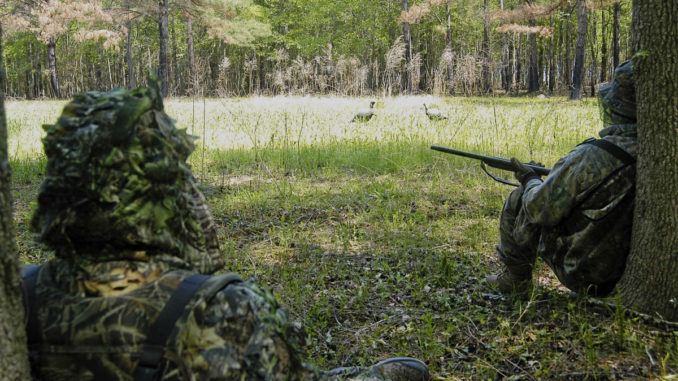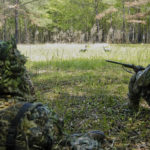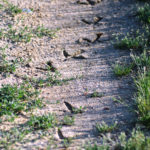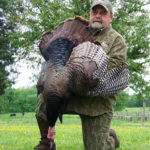
Don’t let the last hours of spring turkey season tick away without using some new tricks
One May morning a few years ago, I sat in heavy cover beside a small, weed-filled Orange County field. My heart thumped in my chest like a bass drum.
A turkey gobbler had answered some soft yelps I’d made with a slate call. About 30 minutes after the morning fog had melted off, he pitched out of his tree and landed in a large field about 150 yards from me.
I’d only yelped four times. Because of his response, I figured he’d turn and walk down the side of the adjoining field where I’d placed two turkey decoys — a jake and a hen — about 30 yards in front of my 12-gauge Remington shotgun.
To my surprise, he didn’t turn but he walked away, gobbling constantly while waiting for my faux hen to join him.
I’d made the mistake of not scouting and hadn’t seen a low, vine-covered fence between the fields. If I’d known about the fence, I’d have set up at its corner and intercepted the bird.
About a week later, I decided to try him again. As I walked down a logging road before daylight, he gobbled 300 yards away — so I thought — in a woody ravine that bordered a different field. I walked the field’s edge, placed my two decoys and sat down with my back against a large oak.
The tom, who’ had been watching me, flew out of a tree about 75 yards away.
My second mistake had been not realizing that the woods, which had greened-up appreciably, had muffled his gobbling, and he’d been half as far away as I’d guessed.
Blown chances are part of many errors turkey hunters can make as the season extends into May. But several others factors come into play to make filling a turkey tag a little tougher in the last week to 10 days of the season.
A major one is hunting pressure. North Carolina’s spring gobbler season only lasts a month — it opened April 11 and closes May 9 — so hunters flock to their hunting public lands the first couple of weeks, walking, talking and calling. Because of all that activity, gobblers become suspicious and soon figure out what’s causing the ruckus. Older, wiser birds clam up.
Still, all isn’t lost. The mating urge for wild turkeys extends through the spring, and near the end of the season, unbred hen turkeys are few and far between, so gobblers are anxious to find them.
Marshall Collette of Greensboro and Fred Cox Jr. of Reidsville are experienced gobbler chasers.
A past state turkey calling, gobbling and owling champion, the 59-year-old Collette has a bag of tricks for late-season birds. His No. 1 rule isn’t really a rule but an acquired trait learned through observations — accurately imitating a hen’s yelp.
“By May, turkeys have been stressed out by all the calling and cutting at them, and 80 percent of it has been too loud and too long, but the most important thing is the cadence isn’t right,” Collette said, describing the speed and rhythm of yelping.
“Some people never listen to turkeys. I made it a point to listen to barnyard and wild turkeys to hear the speed of the yelp. It makes all difference in the world.
“I think turkeys can spot a fake yelp cadence. Cadence doesn’t matter so much in cutting or cackling because those calls are faster. But a hen’s six- or seven-yelp cadence in the spring has a certain rhythm.”
Collette said he only uses three calls late in the season — a double-reed mouth call, a push-pin yelper and a slate call.
“The key thing is to call as soft as you can, making basic hen yelps, clucks and purrs,” he said. “If I’m at game lands or big club lands that have been hammered a lot, I don’t need to call to gobblers very loud at the end of the season. I tone my calls way down. If I’m on private land that hasn’t been hammered, I might call like I did early in the season.”
Cox, who owns Grand Slam Turkey Calls and is a past national wing bone calling champion, agreed that soft-calling and fewer calls are two keys for enticing birds into shotgun range.
“You can call bigger birds without aggressive calling,” he said. “Soft clucks, purrs and tree yelps are good in the morning. When the wind gets up, you probably should call a little louder because they won’t be able to hear a soft call. But soft-calling usually works if you happen to hunt the first half of the day.”
Cox, a 63-year-old former high-school teacher, prefers an old-school approach to calling.
“I like wing bones for basic yelping,” he said. “I hold to three to five notes and close off the end of the call to make soft yelps. You also have the option to use a wing bone in the middle of day when you need to get louder. It really carries, and nothing else sounds like a wing bone.”
But Cox agreed with Collette that a push-pin call can be an essential part of a turkey hunter’s arsenal.
“Every hunter has slate, box and mouth call,” Cox said. “But most people don’t carry a push-pin call. It can be really effective. A lot of gobblers have been killed coming to a push-pin call.”
Push-pin calls are easy for beginners to use because the cadence and tone are easy to vary. A moving thumb on one hand can produce yelps, clucks and purrs with a push-pin.
In recent years, hunters have complained about a lack of gobbling, especially late in the season.
Besides hunting pressure, some believe an increase in the population of coyotes and foxes has helped to silence gobblers, but Collette pointed to a biological reason.
“I think early in the season, the lack of gobbling is caused by dominant gobblers beating up other birds,” he said. “The 2- and 2 1/2-year-old birds learn pretty quickly if they don’t shut up, they’re going to get their butts kicked by a boss gobbler.”
Later on, if a dominant bird is killed, gobbling usually begins again.
“Mike Seamster (the former N.C. Wildlife Resources Commission wild-turkey project leader) told me he noticed several cycles,” Collette said. “Turkeys will gobble, then stop, then gobble again, then stop again. Mike said there are two or three gobbling cycles (each spring).”
Cox added another reason for reduced gobbling.
“Older gobblers’ roost sites tend to be near nesting areas in the late spring where the hens are,” he said. “They don’t do a lot of gobbling, maybe once in the morning. Their only job is to get up and service hens.”
Cox believes most gobblers killed in May are less-wary 2- to 2 ½-year-old birds.
“But if you want to kill an older gobbler, I think you have to change tactics from the first part of the season and center around nesting areas more than conventional roosting areas,” he said. “Even though some boss gobblers might roost in traditional areas, after they fly down, they head straight for nesting areas.”
Another factor, he said, is that once hens nest, they become homebodies, as opposed to April when they hurry toward gobblers.
“When hens are nesting — and most of them will have nests by May — they don’t go to gobblers,” said Cox, who agreed that gobblers have become educated to calls by May — and that tendency may be increasing.
“Wayne Bailey (North Carolina’s first wild-turkey biologist) told me a long time ago male turkeys eventually will breed gobbling out of themselves,” Collette said.
Bailey, according to Collette, believed when that a gobbler who responded to a hunter’s call and was shot, his call-response tendency was eliminated from the gene pool. That left breeding to birds that avoided hunters’ calls. And those call-avoidance genes were passed on to the next generation of turkeys.
Given that gobblers, especially boss birds, are more difficult to entice in the late season, how do Collette and Cox solve the problem?
Both said getting as close to roosting gobblers as possible is a good idea.
“If I get to the woods and hear a gobbler that’s still on the roost, I try to get inside 100 yards of him,” said Collette, a member of the Quaker Boy and Mossy Oak pro staffs. “You can do that in May because the leaves give you cover.
“Then, I yelp as softly as I can, probably five or six times, building up. If the gobbler answers, I don’t answer back. I may scratch in the leaves with a stick. He knows where I’m at, so that’s where patience comes in. I’m liable to sit for two hours. You need patience to wait him out.”
As for areas where hens nest, Cox said he likes fields with overgrown edges or cutovers.
“Older gobblers will be near nesting hens, and hens don’t stray too far from their nests,” he said.
Plowed fields are especially good feeding areas.
“In the afternoon, I hunt fields near where I heard gobbling in the morning,” Cox said.
Collette said during the late season, he almost exclusively hunts fields during the afternoon and evening.
“I like the corners of fields and pastures, especially cut corn and bean fields,” he said. “Gobblers are always looking for hens, and hens often will be at field and pasture corners where they can find insects or left-over grain. If you combine that with a few soft feeding calls, soft clucks and purrs, a longbeard may come right to you.”
Of course, all these suggestions depend upon preseason scouting, which includes observing turkeys, looking for sign such as tracks and droppings and listening for gobbles at daylight.







Be the first to comment